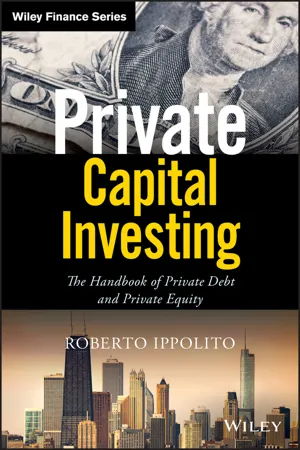
Private Capital Investing
The Handbook of Private Debt and Private Equity
- English
- ePUB (mobile friendly)
- Available on iOS & Android
About this book
A step-by-step, comprehensive approach to private equity and private debt
Private Capital Investing: The Handbook of Private Debt and Private Equity is a practical manual on investing in the two of the most common alternative asset classes (private equity and private debt) and provides a unique insight on how principal investors analyze investment opportunities. Unlike other textbooks available in the market, Private Capital Investing covers the various phases that principal investors follow when analyzing a private investment opportunity.
The book combines academic rigor with the practical approach used by leading institutional investors. Chapters are filled with practical examples, Excel workbooks (downloadable from the book website), examples of legal clauses and contracts, and Q&A. Cases are referred at the end of every chapter to test the learning of the reader. Instructors will find referrals to both third-party cases or cases written by the author.
• Covers analytical tools
• Includes the most common methods used to structure a debt facility and a private equity transaction
• Looks at the main legal aspects of a transaction
• Walks readers through the different phases of a transaction from origination to closing
Bridging the gap between academic study and practical application, Private Capital Investing enables the reader to be able to start working in private equity or private debt without the need for any further training. It is intended for undergraduates and MBA students, practitioners in the investment banking, consulting and private equity business with prior academic background in corporate finance and accounting.
Frequently asked questions
- Essential is ideal for learners and professionals who enjoy exploring a wide range of subjects. Access the Essential Library with 800,000+ trusted titles and best-sellers across business, personal growth, and the humanities. Includes unlimited reading time and Standard Read Aloud voice.
- Complete: Perfect for advanced learners and researchers needing full, unrestricted access. Unlock 1.4M+ books across hundreds of subjects, including academic and specialized titles. The Complete Plan also includes advanced features like Premium Read Aloud and Research Assistant.
Please note we cannot support devices running on iOS 13 and Android 7 or earlier. Learn more about using the app.
Information
CHAPTER 1
Closed End Funds
A CLOSE UP ON PRIVATE EQUITY AND PRIVATE DEBT PARTNERSHIPS
- General partner (GP): the manager is called the general partner and has potentially unlimited liability for the actions of the fund. To put a cap on this potentially unlimited liability, GPs are limited companies or partnerships. The GP interest is the fund manager's participation of his capital in the fund. Technically, the fund manager invests in the general partner; however, in common usage, limited partners are investors and GPs are fund managers. GPs are compensated with an incentive allocation of capital appreciation, called carried interest. Loss carry-forwards in the partnership structure ensure that GPs do not receive their incentive allocation until all the losses of limited partners have been recovered. Similarly, claw-backs in the structure ensure that GPs do not receive an over-distribution of gains. Hurdle rates ensure that GPs do not receive an incentive allocation until investors recover their original investment and make a preferential rate of return on their investment. When the structure does not foresee a management company, the GP is entitled to also receive the management fee.
 FIGURE 1.1 A typical private equity (debt) fund structure.
FIGURE 1.1 A typical private equity (debt) fund structure. - Limited partner (LP): external investors are...
Table of contents
- Cover
- Table of Contents
- About the Author
- Acknowledgements
- About the Companion Site
- Introduction
- CHAPTER 1: Closed End Funds
- CHAPTER 2: Debt Products
- CHAPTER 3: Equity Products
- CHAPTER 4: Business Due Diligence
- CHAPTER 5: Accounting Due Diligence
- CHAPTER 6: Business Plan
- CHAPTER 7: Valuation
- CHAPTER 8: Growth Equity
- CHAPTER 9: Leveraged Buyout
- CHAPTER 10: Management of the Portfolio Companies and Exit
- CHAPTER 11: Private Debt
- CHAPTER 12: Legal Documentation
- CHAPTER 13: Distress Symptoms and Remedies
- Index
- End User License Agreement